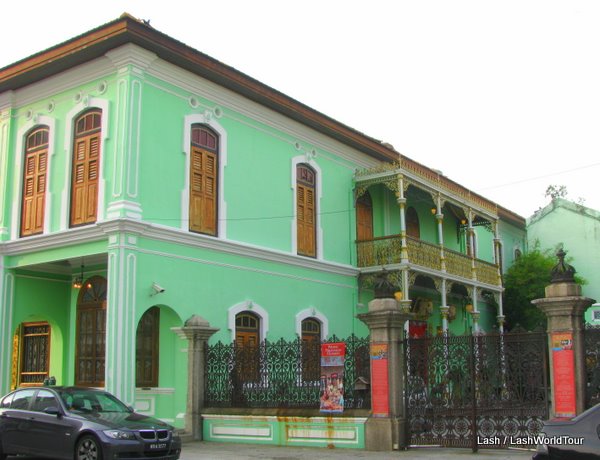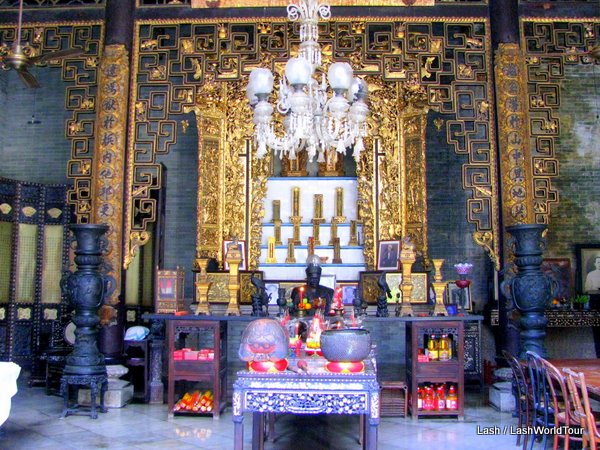REVIEW OF PINANG PERANAKAN MANSION
A few days ago, I excitedly walked over to Penang’s famous and unique museum, the Pinang Peranakan Mansion. I was warmly greeted by their kind, friendly staff, who handed me an informative brochure. The staff had no idea I was a guest travel blogger coming to review the Mansion. During the two hours of my visit, I noticed that they greeted all the guests that way. Such is the very welcoming arrival to Pinang Peranakan Mansion.
It was a busy morning for the Mansion: a cruise ship full of German tourists were visiting. In addition, several other small groups and couples arrived by taxi or rickshaw to view the beautifully restored colonial home. As a result, I was very fortunate to meet the man behind the museum, Mr. Peter Soon, who was on hand for the tour group, as well as the energetic and adorable older Peranakan woman, Nyonya Annie.
What, you ask, is a Peranakan Mansion? And why is it such a unique cultural attraction? Well…
Peranakan is the name given to an affluent, mixed race culture that’s scattered around Malaysia and Singapore. In Malaysia, they arose mainly in the important trading ports of Melacca and Penang. Peranakans are descendents of Chinese immigrants who married locals and created their own unique lifestyle, borrowing traditions and culture from both their Chinese and Malaysian heritages as well as from the British. Also known as ‘Straights Chinese’, Peranakan men are referred to as Babas, the women as Nyonyas.
Their temples, ancestry worship, furniture, and much of their wedding traditions are more typically Chinese. They favor fancy Chinese furniture of solid dark wood inlaid heavily with mother-of-pearl. On the other hand, Nyonya clothing more closely resembles Malaysian women’s clothing. With it, they wear distinctive Peranakan jewelry and beaded shoes. Babas originally dressed as Chinese gentlemen, but later adopted British attire. As English-educated aristocrats, they also blended in a grand dash of British traditions in their homes, particularly in dining rooms. Their distinctive, colorful tableware and ceramics are uniquely Peranakan. In cuisine, they adopted many Malaysian sweets and spicy foods into their diet.
Pinang Peranakan Mansion, the original home of an affluent Chinese immigrant turned entrepreneur, showcases the rich Peranakan culture, traditions and daily lifestyle. The museum is the brainchild of Mr. Peter Soon, an avid collector of Peranakan and Chinese antiques, who bought the huge dilapidated house in 2001 and lovingly restored it to its former glory. He then was able to furnish it with his 30-year collection of antiques, to complete the masterpiece.
If you’re at all interested in unique cultures, and especially if you’re fond of elaborate artwork (picture intricately-carved and gilded wood panels, inlaid furniture, lacy ironwork, elaborate beadwork and embroidery, colorfully decorated ceramics, large-scale wall paintings) then you’ll absolutely love Peranakan Mansion.
The impressive mint-green mansion in central Georgetown, which is very large by modern standards, must have been absolutely massive when it was built back in 1895 by successful Chinese immigrant-turned-entrepreneur, Kapitan Chung Kee Kwee. Peranakan Mansion was built around a large, square Central courtyard with a granite-slab floor and open to the sky, typical of Chinese homes of the time. That design allowed for both ventilation and sunlight at time when no electricity existed.
On the ground floor, the courtyard is flanked by two grand entry halls (one for men, one for women) and not one, but three, dining rooms: family dining room, business dining room, and friends/locals dining room. Out back there’s even a forth, formal dining room, decorated with delicate Chinese ink paintings. The Peranakan kitchen with its many utensils, pans, baskets, and cooking wares is also out back.
Adjacent to the mansion is the equally grand Chung family temple. It’s fitted out with elaborately carved stone and gilded wood panels, intricate alters, and beautiful potted bonsai. Upstairs are the bedrooms, more lounging halls, and a balcony lined with a wrought iron
The entire mansion is filled with a vast, impressive collection of Peranakan furniture, ceramics, clothing displays, artworks, and daily living objects.
The museum’s brochure gives a brief explanation of each room, with a floor plan, and explanation of Peranakan culture. Guests are welcome to stroll around on their own, exploring the mansion at their leisure. Guides are also on hand to escort guests around, offering more in-depth explanations of Peranakan lifestyle, the rooms, and the collections. Guided tours are free, though tips are greatly appreciated. The Mansion entrance fee is a reasonable 10 RM ($3.35 US).
If the gorgeous mansion, its rather astonishing collection, and Peranakan culture really catch your interest, you might want to pick up a copy of their book, The Pinang Peranakan Mansion, by scholar Chan Suan Choo. Written by an expert on Peranakan culture, the book gives an in-depth account of Peranakan culture and history, Kapitan Chung Keng Kwee, the history and restoration of the house, and the vast antique collection. The book is packed with beautiful photos of the mansion and many of its artworks.
Opening hours: 9:30- 5 pm daily
Entrance fee: 10 RM ($3.35 US) – children under 12 yrs 5 RM
Guided tours: guides are always on hand for free guided tours of the Mansion. Tips appreciated.
Address: 29 Church street, central Georgetown, on the edge of Little India and the Banking District
Telephone: 604-264-2929
Website: PinangPeranakanMansion
* Pinang Peranakan Mansion generously sponsored my visit, however the views and opinions of my tour are my candid perspectives.






















 Hi! I'm Lash, an American nomadic world traveler who's been traveling solo since 1998. I’m passionate about traveling the world nomadically and then sharing it all with you. I hope to inspire you to travel the world, to entertain you with tales from the road, and to help you reach your travel dreams. Welcome!
Hi! I'm Lash, an American nomadic world traveler who's been traveling solo since 1998. I’m passionate about traveling the world nomadically and then sharing it all with you. I hope to inspire you to travel the world, to entertain you with tales from the road, and to help you reach your travel dreams. Welcome! 




7 pings
Skip to comment form ↓
BEYOND GUIDEBOOKS: PENANG CULTURE- LOCAL HOMEMADE SWEETS - LashWorldTour
2012/06/10 at 6:45 pm (UTC 8) Link to this comment
[…] All are baked or fried right on the premises.For more Penang culture, check out my posts on Pinang Peranakan Mansion, Cheong Fatt Tze Mansion and 10 Free Things to do in […]